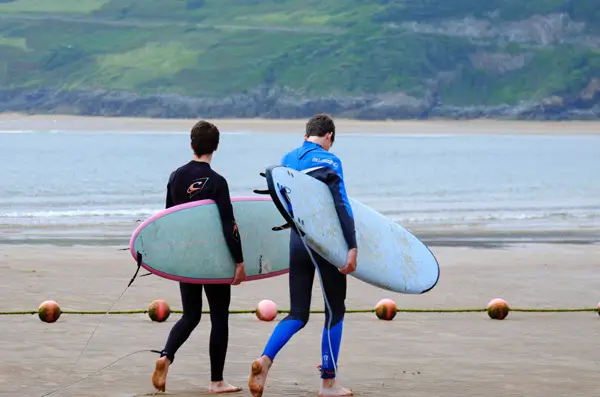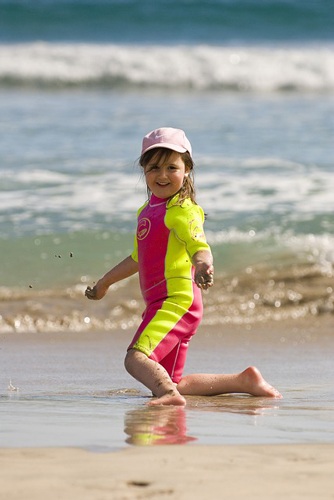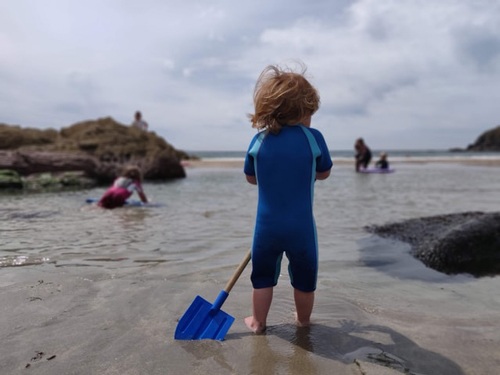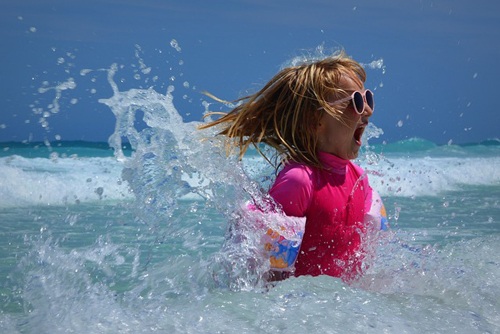Kids Wetsuits

There are many people who love swimming and water sports around the coasts and lakes in the world each year. Adults and children flock to the beaches during the warmer months when the ocean temperature is at its warmest.
Or even during the colder months, myself and my children love to do these activities year-round especially beachcombing and snorkeling. That’s were kids wetsuits are vital in the ocean and for many water sports.
Why buy a children’s wetsuit?

Having children I worry about the right swimwear for activities aside from just playing in the cooling waters on a hot summer day.
Kid’s wetsuits are the answer for those that love to surf, scuba dive, snorkel, wave surf, practice for triathlon swimming and a host of other water sports. What child would turn down a day of jet skiing or water skiing? But one thing I do worry about with children, is there protection and their warmth in the water.
Safety issues like getting stung by Blue Bottled Jellyfish, or other jellyfish, cut by bits of coral or the rocks and exhaustion in the cold. That’s were a children’s wetsuit helps protect them. While not a substitute for a life jacket in the water, the wetsuit can also help with buoyancy as well.
No matter what size or age your child may be, kids wetsuits are a good idea at the ocean or cold lakes and waters.
There are so many choices of suits, styles, colors and thickness, buying one is only to their advantage. One thing to keep in mind is to match your child’s wetsuit for their favorite activity. Such is a kids triathlon wetsuit should be more flexible around the arms for swimming, then say a scuba diving wet designed for cold waters.

Where and how to buy a child’s wetsuit
There are many brands such as Rip Curl, Peak Wetsuits, O’Neill Wetsuits, Xcell Wetsuits, Billabong, Orca Wetsuits, Quicksilver and more to choose from.
Personally, I love to get the best deal since children grow so fast and they might need a new wetsuit every couple of years or so. Not only will I go into these outlets but shop online as well. There is always some great deal waiting just for me. (With a bit of looking around and shopping for some wetsuit sales.)
When buying a wetsuit for children some of the considerations you need to be aware of is what temperature the water will be.
In the summertime and warmer waters, I would suggest a thin wetsuit such as 2 to 3mm neoprene short sleeve. For cooler waters, I would get a hardier wetsuit and thicker neoprene long sleeve with boots for the kid’s wetsuits. Thickness will also depend on the sport as well, such as for scuba inthe northern parts of the US in colder areas, the wetsuit should be thicker and warmer.
If the child is just surfing around hotter areas, then a thinner wetsuits will do the trick.
You can talk to some other parents at the beach about what thickness and size wetsuit for a child. Of course the water sport shop or wetsuit store salesperson might be a wealth of information.
You want to know the best style suited for their age group. There are so many designs to choose from, not just the color array, but how the suit is constructed and where the zippers are. Comfort is what is needed for a kid’s wetsuit.
How to get into a wetsuit
Adults and children who are putting on a wetsuit for the first time are fun to watch. Neoprene is made from rubber so one would think getting into a wetsuit should be easy since rubber stretches. Not true. Getting into children’s wetsuits, same as adult’s wetsuits takes finesse and practice.
First off, sit down on a chair or bench and make sure the wetsuit is facing forward with the back of it facing you.
Carefully and slowly point toes and foot in a downward position while easing your foot, one at a time down into the leg and out through the bottom of the suit. Think of it as if you have long toenails and are putting on a tight pantyhose or skinny jeans with restrictive material. It is a challenge not to rip through the fabric.
With a wetsuit the material will not tear but it is hard to wiggle into.
Once your child’s feet and legs are through gently pull the suit up until you can begin to get their hands and arms in. Whew, all done except for the zipper(s). The wetsuit will feel slightly tight but not restrictive. In the water, the wetsuit will loosen a bit when the liquid seeps in.
One hint I would like to give is when you have your kids wetsuits home and your child or children are getting ready to put it on lightly powder the inside of the wetsuit. Baby powder is ideal, as it makes the wetsuit a lot easier to get on.
For closed cell wetsuits, you can use a small water bottle sprayer with a touch of detergent in it to spray the inside of the wetsuit to help put it on. When working with a thicker 5mm spearfishing wetsuit, the spray bottle works a treat.
A rash vest can also help when putting a wetsuit on, as most have a smooth material. The rashy can also add additional warmth to the wetsuit.

How to wash a wetsuit
When finished using the wetsuit always wash and rinse the children’s wetsuit well. Do not put it in a washing machine.
Get a bucket or put the suit in a clean bathtub run the water and put in a little wetsuit shampoo or a drop of detergent. Wash both the outside and inside, when done washing, change out the water and refill to let the wetsuit soak for a bit, then rinse with running clean water.
Let it air dry and that is all you need to do for your kids wetsuits.
For more detailed step by step information,click on – How To Wash A Wetsuit.
Wetsuits for different activities
If your child loves to surf and the water temperature is warmer, choose the short sleeved with either short bottoms or long bottoms would be ideal. These types of wetsuits give your child the mobility they need to paddle out with their arms and are not restrictive. Some children may prefer full length arms, it is all a matter of choice.
If your child surfs year round in cooler waters, the alternative is simple, get a thicker full wetsuit. Your child will stay warm and the buoyancy of the kid’s wetsuits will make it easier to get back to shore with their board. I would not worry about boots, unless they are on rocks or coral a lot. Some areas with stinging marine creatures like stonefish are a concern, so shoes or solid sandals might be the go, depending on their water sport activity.
Water skiing and using the Jet Ski, would be the same kind of wetsuit as a child’s surfing wetsuit. Children love the fast speed, zipping through and over the waves or wake.
Again, the buoyancy of the wetsuit helps when exhaustion and the chill sets in.
Another benefit of a wetsuit for a child is the wetsuit does not let the UV rays and create a sunburnt child. As a parent you do not have to worry about your kid will coming home looking like a red lobster because of sunburn.
Scuba diving and snorkeling makes for great adventure and for this activity a full wetsuit with hood and boots would be best in the colder months and areas.
Warmth is a big concern because the deeper you go in the ocean or water column, the colder the temperature is. We lose a bit of our heat through our heads and with a hood we stay warmer. No one wants to get hypothermia when they are having a fantastic time exploring underwater. Having boots helps with cuts and bruising from coral, cave walls and sandy or rocky bottoms.
Conclusion. Kids wetsuit
We hope you enjoyed this article and it has given you plenty of information when it comes to choosing kids wetsuit for the diverse climate and waterways.
